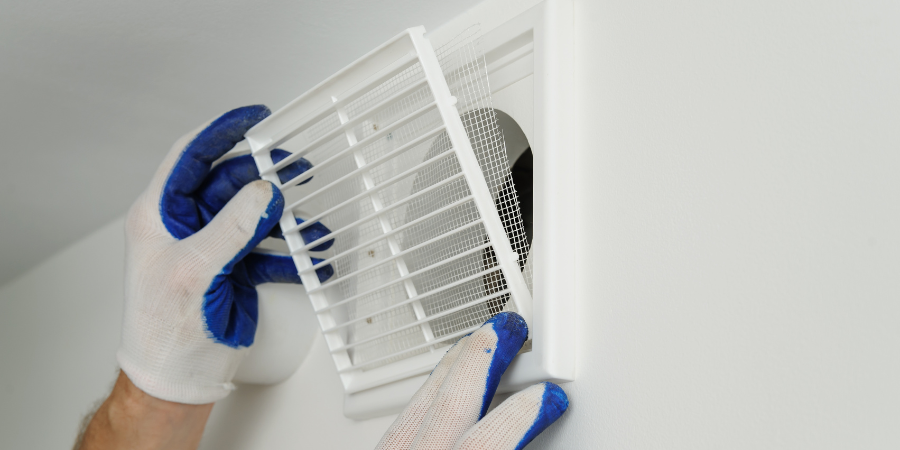Most people are aware of the basic principles of plumbing, which include the delivery of fresh water and the removal of wastewater. Freshwater arrives from water towers via the force of gravity or by using pumps when necessary. Waste removal also depends on gravity, but it also requires the assistance of fresh air. This is where plumbing ventilation comes into play.
In this article, we will explain what a plumbing vent is and the difference between a wet and dry vent. We will then discuss the purpose of plumbing vents and what occurs when they become blocked and can no longer serve their purpose. Lastly, we will outline the common signs a vent is blocked and ways to prevent blockages from occurring.
What Is Plumbing Ventilation
Ventilation is needed within a plumbing system to keep plumbing drains operational. The ventilation system consists of vent pipes attached to a single or multiple plumbing fixtures at one end and travel out through the roof of a home at the other end. These vents are also called vent stacks or plumbing air vents and serve two primary purposes.
What Purpose Do Vents Serve?
The first job of a vent pipe is to assist with wastewater removal. When a toilet is flushed or a faucet is turned on, gravity pulls the water out of the pipe through the drain, creating a vacuum. The vacuum must be filled with fresh air to create an equalized pressure in the line so the drain can flow smoothly. This air is supplied through the roof vent.
A second purpose of the ventilation system is to release foul-smelling odors from the plumbing system to the outdoors. Cooking smells or those generated in the bathroom are not odors anyone wants lingering in their living spaces. Ventilation pipes control indoor odors by carrying them out through a home’s roof vent.
Dry Vent
A dry vent carries only air from a single plumbing fixture, such as a toilet. It relieves the plumbing system of the negative pressure created when wastewater flows out of a drain by supplying the necessary fresh air to keep drains flowing smoothly.
Wet Vent
Unlike a dry vent that transports air only, a wet vent carries air and water with the air moving above the water. Wet vents are used when multiple fixtures share a drain. A wet vent will drain water from one fixture while venting the air from multiple fixtures.
Causes Of A Blocked Vent
A blocked plumbing vent is a serious problem requiring immediate attention to avoid the consequences of an airless plumbing system. Here are the three most common causes of a blocked roof vent.
Birds
Since the vent pipe is located on the roof, it is exposed to the outdoors. This makes it an ideal spot for birds and other small animals to build their nests, and as they do, they restrict or completely stop fresh air from entering or exiting the vent pipe.
Balls
The size of the roof vent is a good match for tennis and other sports balls that accidentally find their way onto the roof. Once they lodge in the vent pipe, they are virtually invisible and can go undetected without getting out a ladder for an inspection.
Debris
The most common cause of a blocked roof vent is the accumulation of sticks, leaves, and other debris. These can be manually removed but, again will require climbing on the roof, which is not recommended as a DIY project.
Signs A Vent Is Blocked
Since the pipe interior is hidden from street view, educating yourself on the signs of a blocked vent is vital. Unfortunately, however, these signs can also be attributed to clogged plumbing pipes, so a professional should be engaged to determine the correct cause.
Sewage Smells
If an unpleasant sewage smell persists, you can suspect a blocked vent. As waste matter decomposes in the sewer system, it produces foul-smelling and harmful gases. These gases typically would be released outdoors through the roof vent, but when the vent becomes blocked, the sewer gases get trapped and invade living spaces.
Drain Gurgling
As stated, fresh air is needed to balance the pressure in the plumbing line whenever a toilet is flushed or a spigot is opened. When the vent becomes inoperable and no longer permits fresh air into the system, the remaining vacuum makes a gurgling noise as wastewater attempts to flow out of the drainpipe.
Slow to Empty Drains
Drain pipes require gravity and fresh air to stabilize the pressure inside plumbing pipes. A blocked vent will cause drains to empty more slowly since the pressure is imbalanced. This is not only an inconvenience but a serious issue that requires professional attention. This is because slow-to-empty drains may be due to a blockage in the sewer line preventing wastewater from exiting correctly
.
Preventing Blocked Vents
Prevention is the best defense against a blocked vent stack. Here, we suggest two options for preventing birds, animals, and errant sports balls from entering the pipe.
Insulation
This method is only needed in cold climates where snow and ice can affect the vent. For those living in warm-weather areas, method #2 will only apply.
Deep snow or ice can cause a vent to become buried or blocked. We recommend insulating the vent pipe to help eliminate this problem.
Protective Cover
A screen can be installed over the opening of the vent pipe to prevent anything from getting inside the pipe. This screen should be cleaned during the yearly plumbing maintenance inspection, and the vent pipe should be inspected for debris.
Looking For Vent Stack Maintenance?
We are well-versed in the world of plumbing ventilation and understand the importance of a clear vent stack. It not only aids in wastewater removal but also ensures an odor-free and comfortable home.
Call us to schedule an appointment to unblock a blocked vent or to install preventative devices to keep your vent clear. We pride ourselves in keeping your home safe and your plumbing in good order. Call us today!






